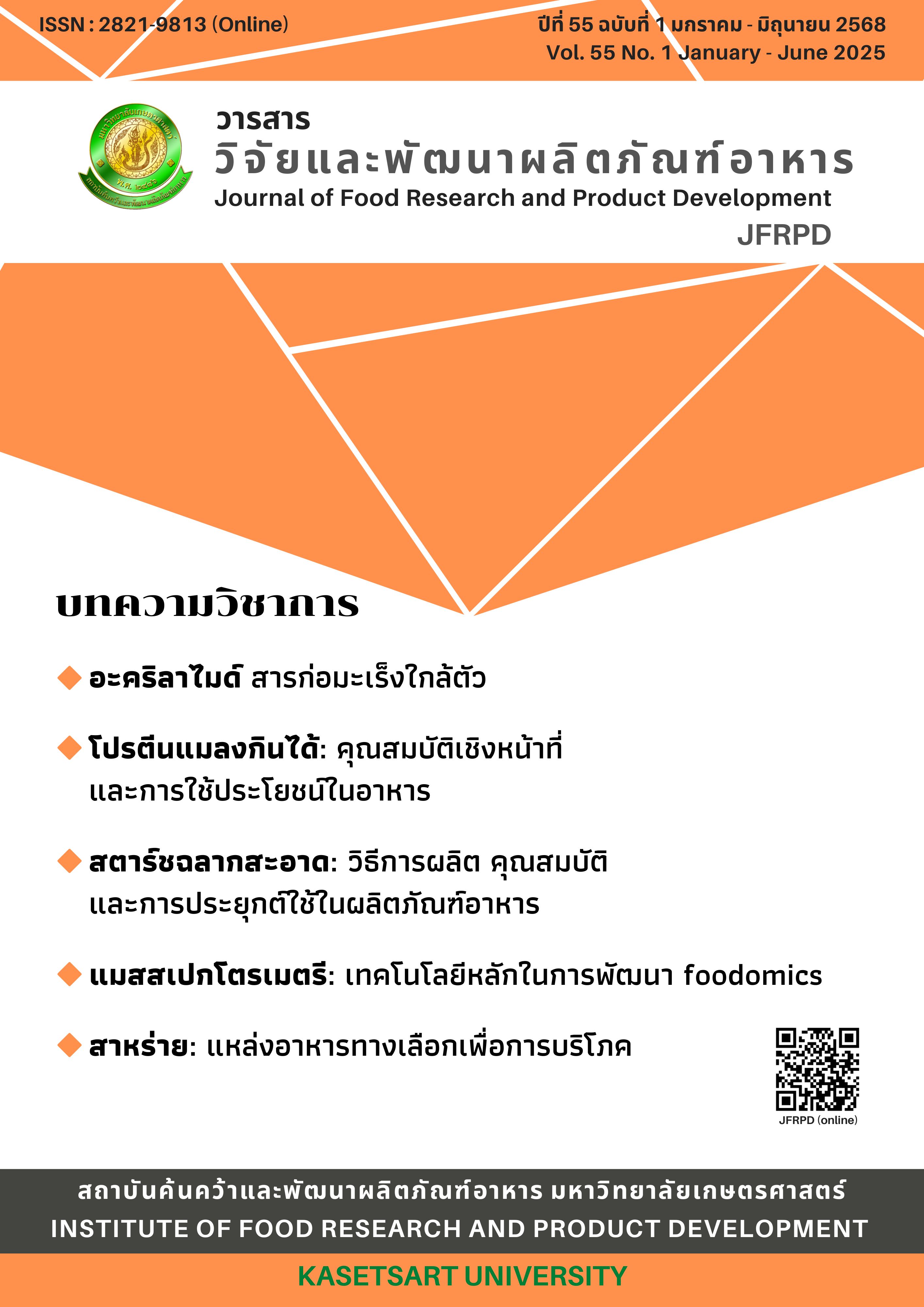Clean-label starch: production, properties and applications in food products
Main Article Content
Abstract
The trend of the health food product market is continuously growing. Clean label starch, starch modified without chemical, is one of the ingredients that play an important role in the transformation of the food industry. Various starch modifications without chemicals, such as blending, physical methods (thermal and non-thermal treatment), and enzymatic modification, provide different starch properties depending on process methods, starch types, and related factors. Most starch blends have their properties that are non-additive behavior. The thermal process results in partial gelatinization of starch. The non-thermal process mainly affects the granular shape and surface area and may change the molecular structure. Enzyme treatment greatly changes the properties of starch due to hydrolyzed molecular structure. Clean label starch remains a challenge in applying process innovations in food industry to effectively produce clean label food products for consumers.
Downloads
Article Details

This work is licensed under a Creative Commons Attribution-NonCommercial-NoDerivatives 4.0 International License.
References
Osborn S. Labelling relating to natural ingredients and additives. In: Berryman P, editor. Advances in Food and Beverage Labelling. Oxford: Woodhead Publishing; 2015. p. 207-21.
Park S, Kim YR. Clean label starch: production, physicochemical characteristics, and industrial applications. Food Sci Biotechnol. 2021;30(1).
Mason WR. Starch use in foods. In: James N. BeMiller RLW, editor. Starch : Chemistry and Technology: Elsevier; 2009. p. 745-95.
Custom Market Insights. Global clean label starch market 2025-2034 updated December 6, 2024. Available from: https://www.custommarketinsights.com/report/clean-label-starch-market/
Presistence market research. Clean label starch market 2023 updated December 6, 2024. Available from: https://www.persistencemarketresearch.com/market-research/clean-label-starch-market.asp
Waterschoot J, Gomand SV, Fierens E, Delcour JA. Starch blends and their physicochemical properties. Starch/Staerke. 2015;67(1-2):1-13.
Puncha-arnon S, Pathipanawat W, Puttanlek C, Rungsardthong V, Uttapap D. Effects of relative granule size and gelatinization temperature on paste and gel properties of starch blends. Food Res Int. 2008;41(5):552-61.
Hagenimana A, Pu P, Ding X. Study on thermal and rheological properties of native rice starches and their corresponding mixtures. Food Res Int. 2005;38(3):257-66.
Chen JJ, Lai VMF, Lii CY. Effects of compositional and granular properties on the pasting viscosity of rice starch blends. Starch/Staerke. 2003;55(5):203-12.
Waterschoot J, Gomand SV, Delcour JA. Impact of swelling power and granule size on pasting of blends of potato, waxy rice and maize starches. Food Hydrocoll. 2016;52:69-77.
Lowithun N. Influence of molecular structure of starch on textural and rheological properties of blended rice gels [Thesis Ph.D. (Food Science)]. Bangkok, Thailand: Kasetsart University; 2023.
Noda T, Tsuda S, Mori M, Takigawa S, Matsuura-Endo C, Kim SJ, et al. Effect of potato starch properties on instant noodle quality in wheat flour and potato starch blends. Starch/Staerke. 2006;58(1):18-24.
Sun D, Yoo B. Effect of tapioca starch addition on rheological, thermal, and gelling properties of rice starch. LWT-Food Science and Technology. 2015;64(1):205-11.
Sasaki T, Kohyama K, Miyashita K, Okunishi T. Effects of Rice Flour Blends on Bread Texture and Staling. Cereal Chem. 2014;91(2):146-51.
Wu K, Dai S, Gan R, Corke H, Zhu F. Thermal and rheological properties of Mung Bean starch blends with potato, sweet potato, rice, and sorghum starches. Food Bioproc. Tech. 2016;9(8):1408-21.
Li S, Ye F, Zhou Y, Lei L, Zhao G. Rheological and textural insights into the blending of sweet potato and cassava starches: In hot and cooled pastes as well as in fresh and dried gels. Food Hydrocoll. 2019;89:901-11.
Stute R, Kern H, inventors; CPC International Inc., Englewood Cliffs, N.J., assignee. Starch mixtures as pudding starches. United States patent 5324532. 28 June 1994.
Wu Z, Qiao D, Zhao S, Lin Q, Zhang B, Xie F. Nonthermal physical modification of starch: An overview of recent research into structure and property alterations. Int J Biol Macromol. 2022;203:153-75.
Dhiman A, Prabhakar PK. Micronization in food processing: A comprehensive review of mechanistic approach, physicochemical, functional properties and self-stability of micronized food materials. J Food Eng. 2021;292:110248.
Zheng J, Li Q, Hu A, Yang L, Lu J, Zhang X, et al. Dual-frequency ultrasound effect on structure and properties of sweet potato starch. Starch/Staerke. 2013;65(7-8):621-7.
Carmona-García R, Bello-Pérez LA, Aguirre-Cruz A, Aparicio-Saguilán A, Hernández-Torres J, Alvarez-Ramirez J. Effect of ultrasonic treatment on the morphological, physicochemical, functional, and rheological properties of starches with different granule size. Starch/Staerke. 2016;68(9-10):972-9.
Nie H, Li C, Liu P-H, Lei C-Y, Li J-B. Retrogradation, gel texture properties, intrinsic viscosity and degradation mechanism of potato starch paste under ultrasonic irradiation. Food Hydrocoll. 2019;95:590-600.
Park SH, Na Y, Kim J, Kang SD, Park KH. Properties and applications of starch modifying enzymes for use in the baking industry. Food Sci Biotechnol. 2018;27(2):299-312.





